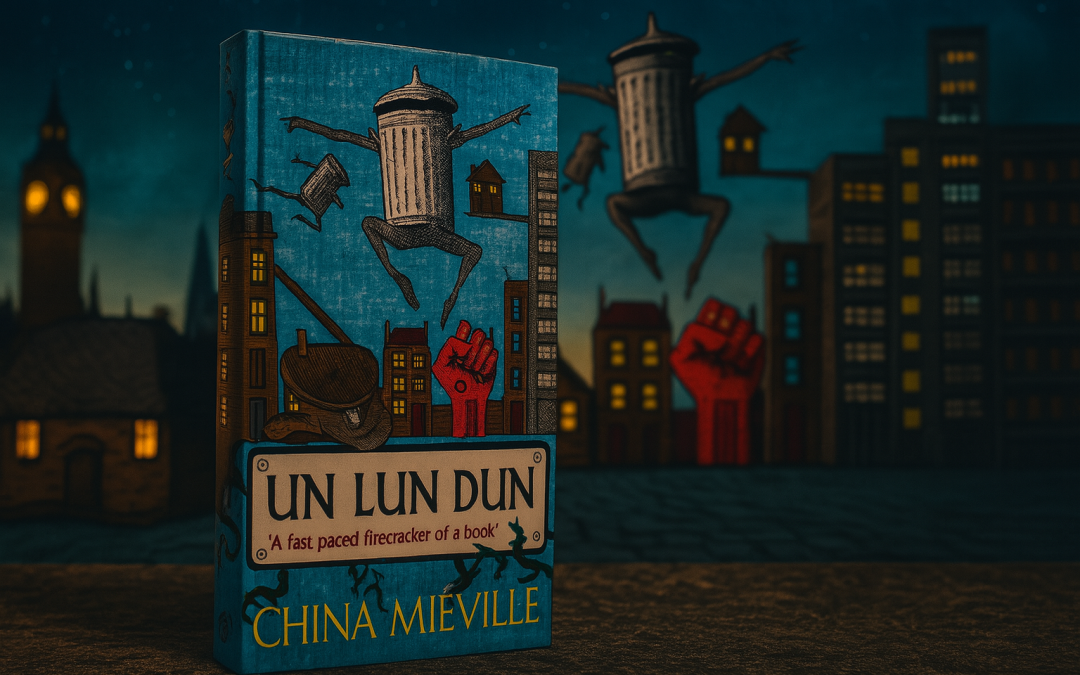China Miéville’s Un Lun Dun transforms London through the strange mirror of UnLondon, a chaotic city constructed from what the surface rejects. Beneath the familiar streets lies an abcity, a surreal space populated by broken machines, forgotten objects, twisted language, and corrupted institutions. This double city draws not only on the idea of urban fantasy but also on psychoanalytic theories of the abject. Julia Kristeva describes the abject as that which must be expelled to create order, yet threatens the system from outside. UnLondon embodies this threat: it is made from what is thrown away, and in its disorder lies its power.
At the heart of the story are two schoolgirls, Zanna and Deeba, who stumble into UnLondon.
At first, Zanna appears to be the Chosen One, the “Shwazzy.” But this fantasy arc unravels. Zanna is quickly sidelined, and Deeba—the overlooked sidekick—rejects the prophecy and becomes the true hero. This shift is more than a plot twist. It is a playful critique of fantasy tropes and a challenge to the narrative structure of the portal-quest fantasy, where movement from the ordinary world to the magical realm typically follows a predictable script. In Un Lun Dun, the magic resists control and the quest takes a different path.
The story emerges against a backdrop of climate anxiety, particularly the early 2000s rise in environmental consciousness. Miéville’s UnLondon is built from waste—consumer leftovers, discarded technologies, broken ideologies—and it absorbs the pollution and problems of the world above. Even the name “Shwazzy” is a warped version of “choisie,” the French word for “chosen,” feminised and mispronounced, a reminder that language, like material culture, gets reshaped in UnLondon.
Miéville uses this city of waste to critique not just environmental neglect but the way society classifies and discards knowledge, people, and institutions. Through metaphors rooted in material culture, ecological decay, and collapsing authority, the novel constructs a vibrant but unstable counter-city. This isn’t a world that simply reflects our own; it decomposes and reconfigures it, asking us to look again at what we throw away.
MOIL: The City Built from Waste
In UnLondon, buildings are constructed from washing machines, radios, and worn-out tools. Trash becomes infrastructure, and meaning is made from ruin. The acronym MOIL—“Mildly Obsolete in London”—describes everything that lands in UnLondon. But “moil” also carries older meanings: to churn, to labour, to toil in confusion. Miéville layers these meanings to suggest that UnLondon is a site of restless struggle. Its discarded artefacts don’t lie still—they work.
This world of waste is not just visual spectacle. It critiques how society defines value and relevance. The things that end up in UnLondon aren’t always useless, just outdated or inconvenient. As Tiffin notes, cities like UnLondon make visible what the dominant culture prefers to ignore: “alienation, difference, and exclusion.” Even fashion leaks between the cities—Londoners imitate UnLondon trends without understanding their origins. The flow of value is not one-way. UnLondon creates as much as it receives.
And yet, reuse does not equal redemption. The streets of UnLondon are “ramshackle,” its sun emits a faint, broken glow. This city is stitched together from scraps and scarred by exhaustion. It is not a utopia but a survival mechanism, a precarious response to the excess of the world above.
The Smog: Pollution Becomes Predator
Among the many metaphors in the novel, the Smog stands out. It is more than a cloud of toxic air—it is a sentient, devouring force. Formed from lightning, soot, and chemical residue, the Smog is the embodiment of everything toxic and uncontained in modern life. It wants to “burn and learn,” absorbing knowledge not to understand but to dominate.
The Smog turns the idea of enlightenment into something grotesque. Rather than preserving knowledge, it incinerates it. It feeds off books, buildings, and people, echoing Baudrillard’s idea of a society where meaning collapses under its own weight. The Smog’s motto, “Know and grow,” is a parody of innovation culture. Here, growth is destruction.
Its followers, known as stink-junkies, are addicted to its fumes. They represent a more sinister metaphor: the commodification of addiction and the psychological capture of consumer subjects. These are not just characters under a spell. They are symptoms of a culture that trains people to crave their own destruction.
Miéville’s critique doesn’t stop there. Some citizens of UnLondon choose to side with the Smog, seeing it as progress. In doing so, they echo real-world figures who prioritise short-term economic gain over environmental health. The Smog is a system, not a monster. It thrives on complicity.
LURCH: Bureaucracy Meets Fantasy
The Smog’s origins lie not just in accident or ancient curse, but in policy. Through the LURCH programme—London-UnLondon Rerouting Carbon Hazards—the government has literally rerouted pollution into UnLondon. This is environmental outsourcing disguised as innovation. London gets cleaner. UnLondon gets sick.
Elizabeth Rawley, the fictional Secretary of State for the Environment, treats LURCH as a PR victory. She dreams of turning the Smog into a “chemical weapon that can strategise like a general.” This isn’t just political cynicism. It’s a metaphor for how modern institutions weaponise crisis under the banner of progress.
Unlike Neverwhere, where the unwanted slip through society’s cracks, Un Lun Dun shows that waste returns—and this time, it fights back. LURCH reveals a darker truth: what we discard doesn’t disappear. It remembers.
The Smog’s Logic: To Know is to Destroy
The Enlightenment believed in knowledge as progress, in learning as liberation. Un Lun Dun twists this idea. The Smog wants to know everything—but only by consuming it. It imagines burning every book to absorb their contents. It doesn’t read; it devours.
This hunger for total knowledge is a metaphor for how data and power have merged in modern systems. Miéville exposes a terrifying possibility: that learning can become conquest. The Smog blurs the line between collecting knowledge and destroying difference.
The Talklands and Webminster Abbey: Broken Institutions
Miéville doesn’t only critique consumerism. He turns his focus on institutions: government, religion, and archives. In the Talklands, speech requires a licence, and words become living creatures. Mr. Speaker rules through verbal tyranny. Speaking becomes violence. Bureaucracy takes on monstrous form.
In Webminster Abbey, language doesn’t explode—it decays. Portals called Black Windows consume one another endlessly, creating recursive loops of failed meaning. The UnGun, the only tool capable of defeating the Smog, is buried inside this mess of decayed symbols. Two bishops wander in confusion, no longer aware of their own purpose.
These spaces show that systems of order can collapse into absurdity. The Talklands controls speech. Webminster loses it. But both warn against overreliance on institutions that no longer serve truth or justice.
Deeba and the Broken Prophecy
At the story’s heart is Deeba—a girl who refuses the script. When she discovers that the prophecy naming Zanna as the chosen one is wrong, she tears it up. This act is not symbolic. It becomes the novel’s argument.
Fantasy often revolves around chosen heroes and destiny. Un Lun Dun asks: what if the story is wrong? What if the sidekick is more capable than the saviour? Through Deeba, Miéville celebrates improvisation, scepticism, and creative agency. She isn’t chosen, but she chooses.
The novel turns genre tropes inside out. Even its metaphors refuse to stay still. They shift, collapse, and rebuild, just like the city itself. Miéville uses fantasy not as escape, but as confrontation. His metaphors expose the systems we live inside: of waste, knowledge, and control.
And sometimes, the things we throw away turn out to be the ones that save us.

D.P. Martinez is a contemporary fantasy author specialising in urban fantasy and magical realism. He holds an M.A. in English Literature from the University of Greenwich, where he focused on Literary London. His research explored metaphorical representations of London in urban fantasy. He has written hundreds of articles and several books across both fiction and non-fiction.

